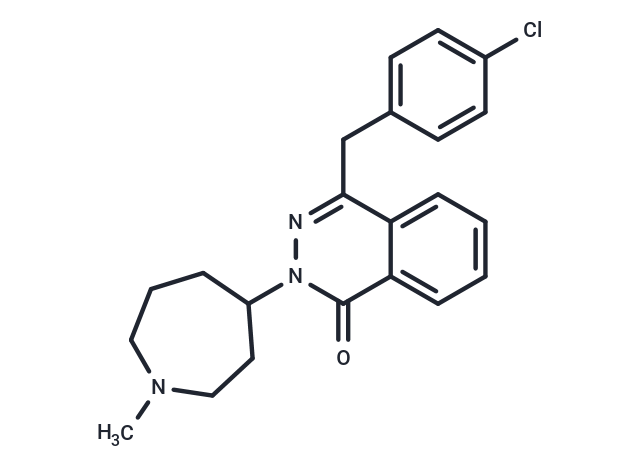Shopping Cart
- Remove All
 Your shopping cart is currently empty
Your shopping cart is currently empty

Azelastine (Azelastinum) is a phthalazine derivative, and is an histamine antagonist and mast cell stabilizer.

| Pack Size | Price | Availability | Quantity |
|---|---|---|---|
| 100 mg | $50 | In Stock |
| Description | Azelastine (Azelastinum) is a phthalazine derivative, and is an histamine antagonist and mast cell stabilizer. |
| In vitro | Azelastine inhibits Ag- and ionomycin-induced TNF-alpha release with IC50 values of 25.7 mM and 1.66 mM, respectively, in a rat mast RBL-2H3 cell line. Azelastine also inhibits TNF-alpha mRNA expression, TNF-alpha protein synthesis and release, and, possibly related to these effects, Ca2+ influx, in Ag-stimulated cells. Azelastine inhibits TNF-alpha release to a greater extent than mRNA expression/protein synthesis and Ca2+ influx in ionomycin-stimulated cells, suggesting that Azelastine inhibits the release process more potently than transcription or production of TNF-alpha by interfering with a signal other than Ca2+. Azelastine added 1 hour after ionomycin stimulation also immediately blocks subsequent release of TNF-alpha, which has been produced in the cells, without affecting Ca2+ influx. Azelastine inhibits ionomycin-induced, but not Ag-induced, protein kinase C translocation to the membranes. [1] Azelastine hydrochloride (Azeptin) dose-dependently suppresses both DNA and protein synthesis in human gingival fibroblasts (HF) and also suppresses blastogenesis of human peripheral blood lymphocytes (PBL). Azelastine hydrochloride (Azeptin) suppresses both inducible nitric oxide synthase-mRNA level and NO generation in mouse peritoneal macrophages. [2] Azelastine inhibits secretion of IL-6, TNF-alpha and IL-8 as well as NF-kappaB activation and intracellular calcium ion levels in normal human mast cells. [3] |
| Alias | Azelastinum, Azelastina, Astelin |
| Molecular Weight | 381.9 |
| Formula | C22H24ClN3O |
| Cas No. | 58581-89-8 |
| Smiles | CN1CCCC(CC1)n1nc(Cc2ccc(Cl)cc2)c2ccccc2c1=O |
| Relative Density. | 1.25 g/cm3 |
| Storage | Powder: -20°C for 3 years | In solvent: -80°C for 1 year | Shipping with blue ice. | ||||||||||||||||||||
| Solubility Information | DMSO: 3.82 mg/mL (10 mM) | ||||||||||||||||||||
Solution Preparation Table | |||||||||||||||||||||
DMSO
| |||||||||||||||||||||

Copyright © 2015-2024 TargetMol Chemicals Inc. All Rights Reserved.